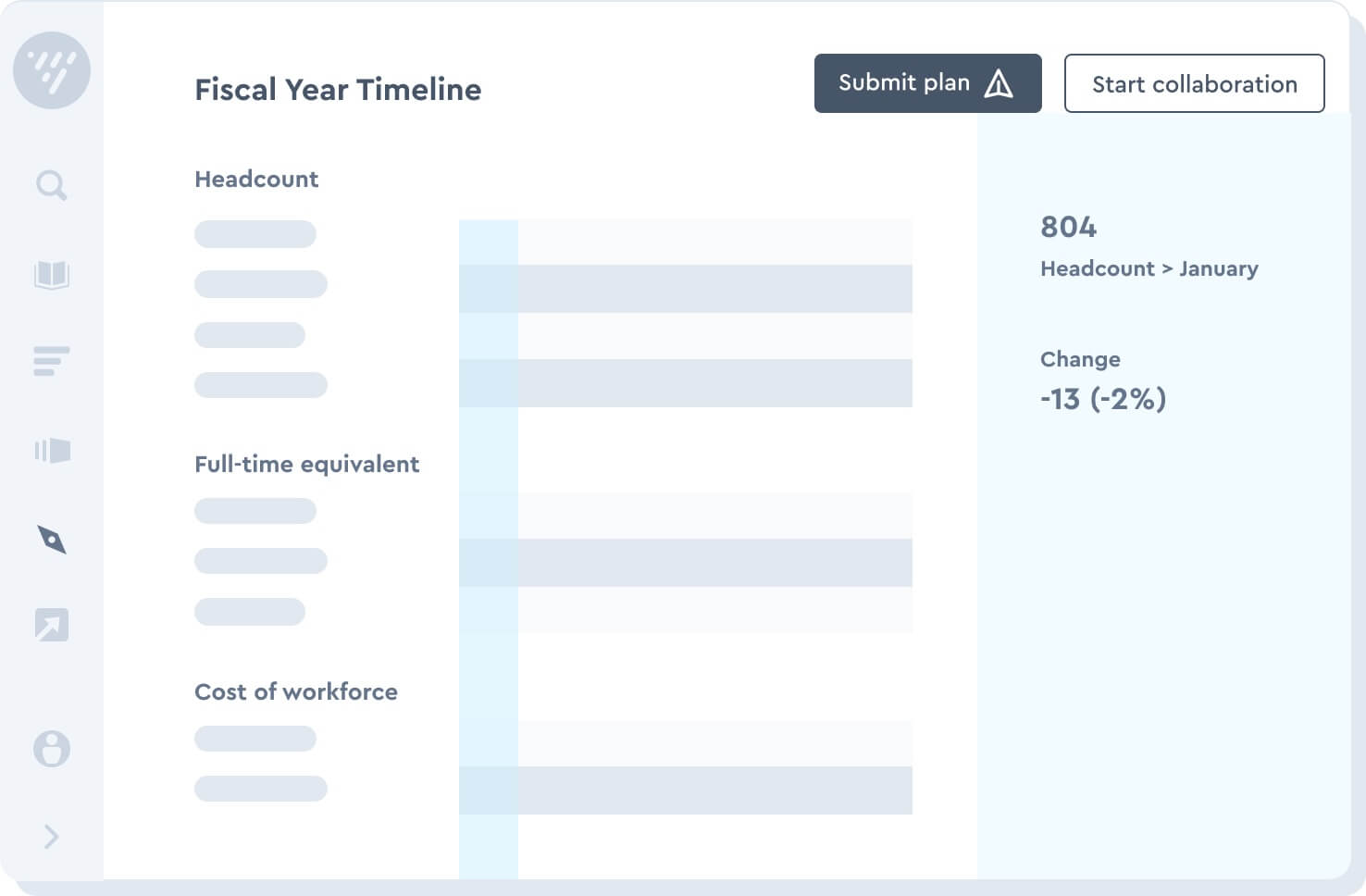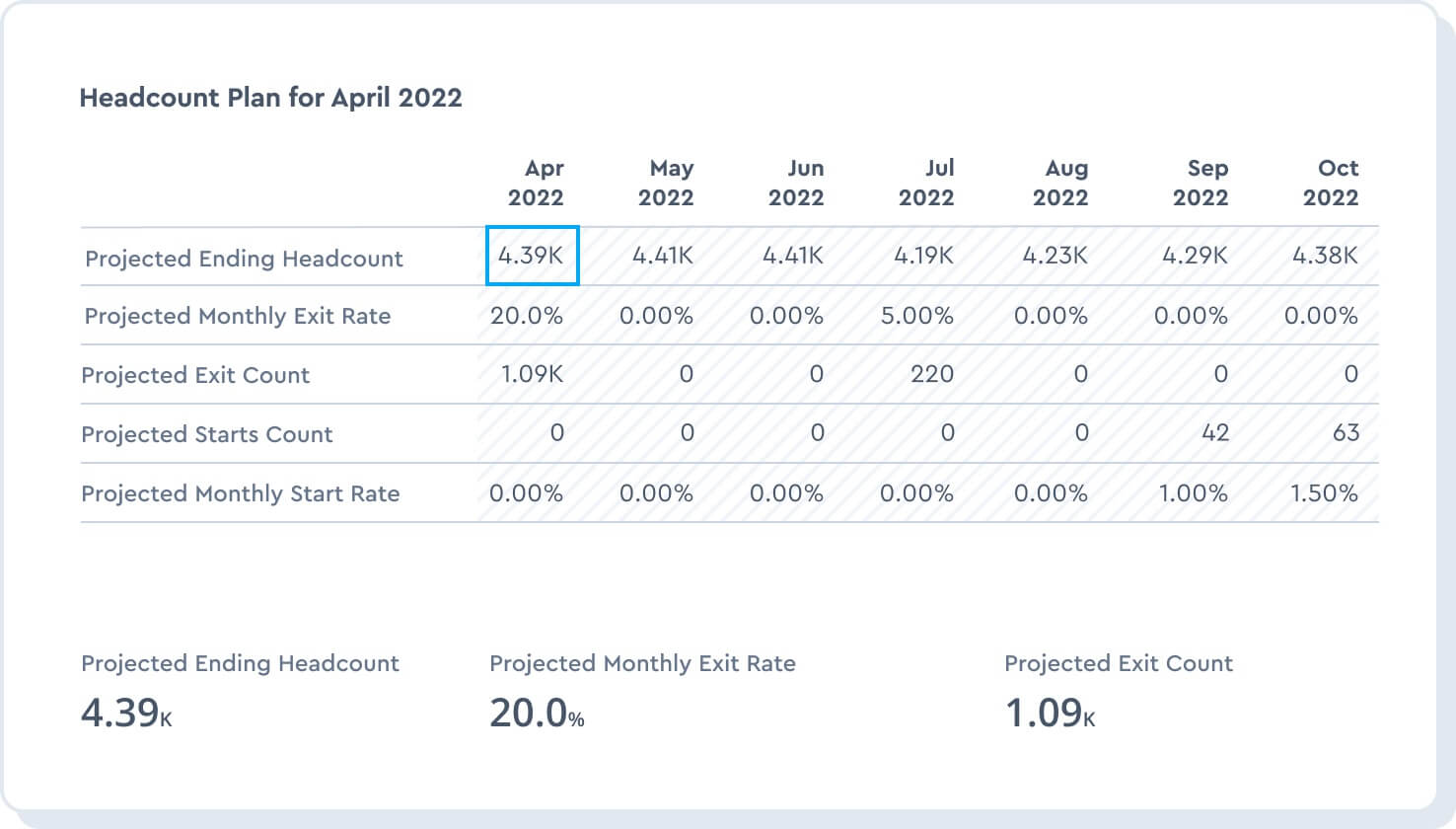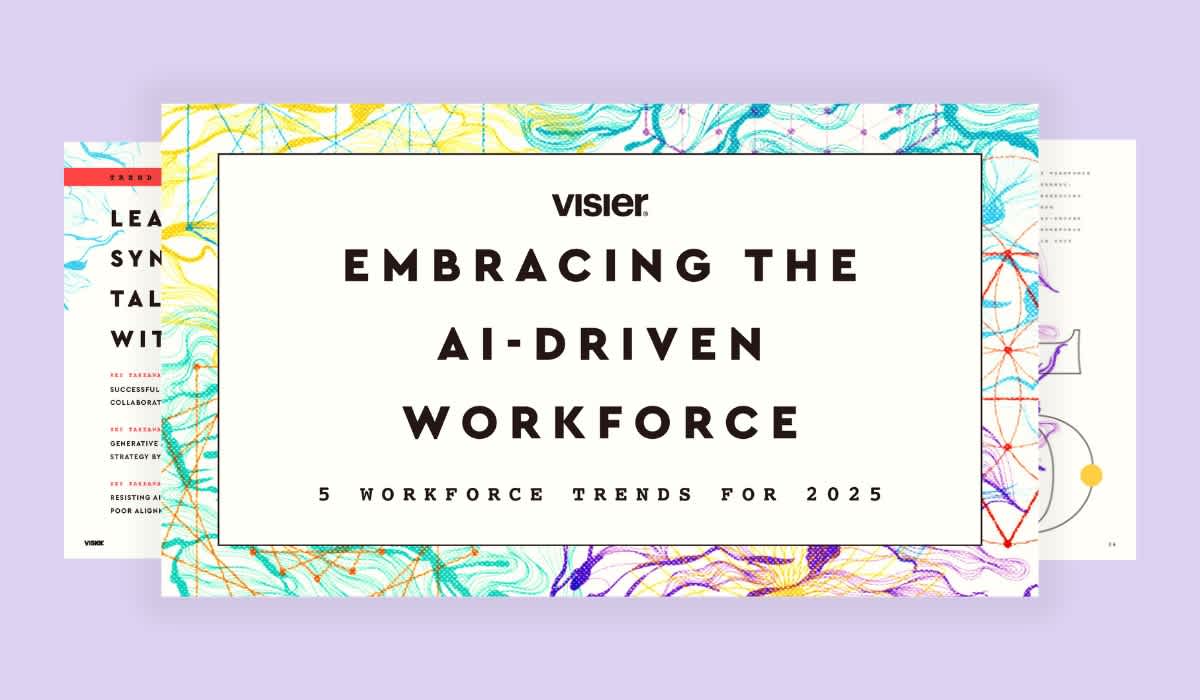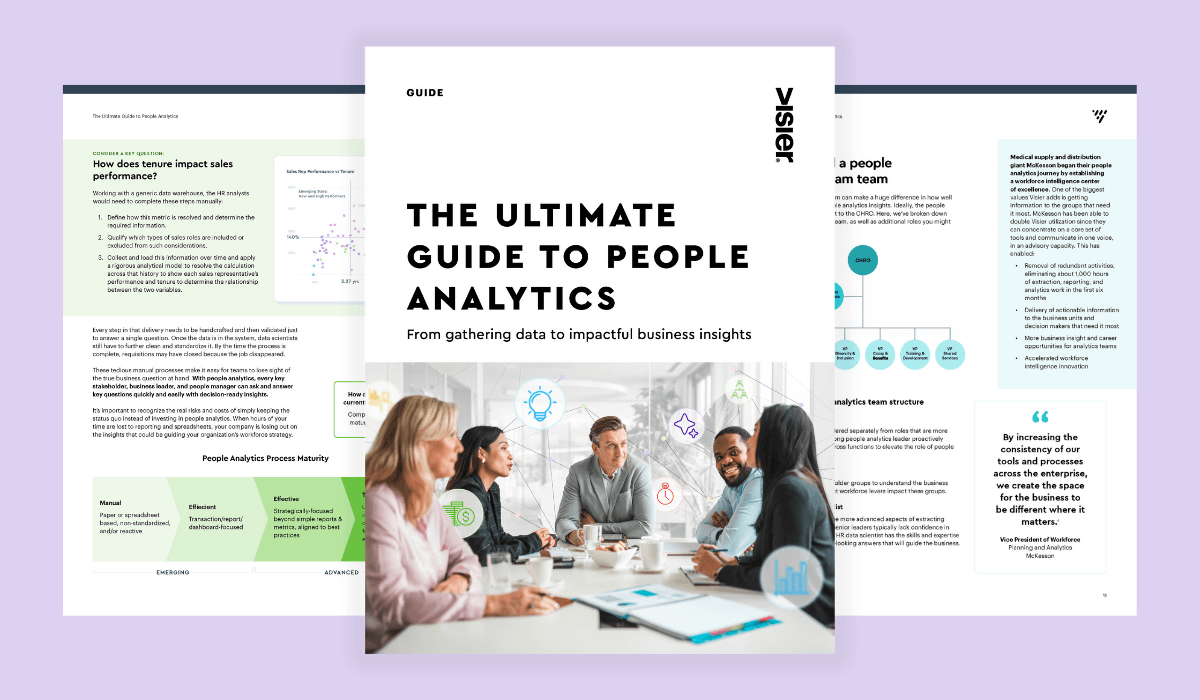How To Keep HR and Finance in Sync on Headcount Planning
Effective workforce planning requires HR and Finance work as a team. Here's how HR and Finance can keep in sync during three core stages.

With the economy consistently fluctuating, leadership teams are looking for ways to streamline their workforce and tightly control their expenses. Headcount planning is used to inform how much—or how little—a company is able to spend on their workforce, while still meeting current and future company needs. Total compensation packages for
employees account for roughly 70% of a company’s annual budget. Nothing affects profit margins and operational runway like headcount.

Companies with headcounts that exceed their requirements will face issues with cash flow as economic conditions shift. But those that don't have an adequate enough headcount—especially when it’s paired with significant skills gaps—are equally vulnerable and risk falling behind the competition and customer expectations.
Headcount planning—a component of workforce planning—is one key tactic that organizations use to keep this fine balance between too much and too little in check. With the right strategy and collaboration across departments, companies can closely monitor and control their headcount and total cost of workforce (TCOW) to ensure that they remain operationally solvent and able to pivot to seize new opportunities as needed.
What is headcount planning?
Headcount planning is a strategy and process that organizations use to ensure they have the right type and number of employees—and the right organizational structure—to meet their short- and long-term goals within a set total cost of workforce budget.
The goal of headcount planning is to ensure that the organization has skills coverage across departments to meet today’s needs and tomorrow’s goals. It’s a collaborative process, involving human resources, finance, department managers, and senior leadership to account for high-level and ground-level requirements across the organization.
After headcount planning is complete, senior leadership can use the results to decide if they need to hire new employees to fill priority skills gaps, restructure the organization to streamline the existing workforce, or conduct a round of layoffs to reduce staff numbers.
Three key benefits of headcount planning include:
Greater agility. The process ensures that organizations can audit their current position and adapt to changing markets, technologies, and company needs.
Better efficiency. Keeping tabs on what skills are present in the organization, and where they’re deployed, ensures that the right staff, with the right skills are in the right positions to maximize impact and efficiency.
Stronger talent management. Headcount planning is a critical step to ensuring companies have the systems and processes needed to align HR, recruitment, and management strategies with core business objectives. It helps teams set talent goals, salary ranges, and bonuses with more transparency into how that impacts the company’s objectives.
These are just three examples of how headcount planning benefits an organization. The impact is wide-reaching and is a key consideration for finance and senior leadership teams as they enter shifting economic climates.

The difference between workforce planning and headcount planning
Put simply, all headcount planning is part of a larger workforce planning initiative, but not all workforce planning activities involve headcount planning.
Workforce planning involves taking stock of existing human resources, and reconciling them against current and future strategic needs. It doesn’t necessarily examine how many people are at the organization, how much they cost, and whether or not they’re in the right places in the org chart.
Headcount planning is slightly different in that it aims to ensure that the organization has the right people in the right place and that the total expenditure is inline with the company’s budget. If they don’t, it helps to determine what steps need to be taken to either increase, decrease, or reorganize the headcount.
The two activities are closely aligned and often go hand in hand. Where possible, it’s likely best to perform both headcount and workforce planning in tandem.
What is the headcount planning process?
The headcount planning process starts with agreeing on what challenges the company is hoping to solve, who should have input into the process, and where most of the attention should be focused.
According to Forbes, “Collaborating across all departments is imperative to an accurate headcount plan…A road map to successful headcount planning begins with an assessment of the talent you have in place versus the talent needed to grow your business in the coming year.”
Understanding the who, what, and where of headcount planning will ensure that the process remains focused on the most impactful goals and outcomes.
Once those three questions are settled, the process is typically broken into 10 key steps.
Identify business challenges. What are the short- and long-term goals and challenges for the organization? What is getting in the way of reaching those goals currently? What external factors need to be taken into account?
Establish success metrics. What organizational and HR metrics will you measure to audit existing headcount and performance? What does success look like for those metrics? What does failure look like?
Analyze and audit data. Use internal and external data sources to capture and analyze key data that help to inform success or failure points in the existing headcount and org structure.
Gather feedback from employees. Don’t forget to include employee insights into the audit phase. They will provide invaluable insights into ground-level operations that might be positively or negatively impacting progress toward goals. They can also help to flag areas where the company is under or over indexed on talent.
Evaluate the current workforce. Perform a gap analysis between where the company needs to be, and what the current workforce can do. Look at the presence and distribution of vital skills across departments, and assess current performance trends.
Identify skills and hiring gaps. Focus on what skills exist in the organization, and what skills are absent. Cross reference that against current and future needs for the organization. In doing so, reflect on whether these skills gaps can—and should—be filled via internal mobility or external hiring.
Forecast costs. This is where the finance team comes into play. Here, they can help to establish a baseline cost for the workforce, and forecast how much it will cost to fill skills gaps. They can also help to identify risks or over-indexing that may cause the workforce budget to exceed the company’s runway.
Creating a roadmap. Based on the workforce audit and cost forecast, is there room to hire new employees? Is the budget flat, meaning that a restructuring and retraining initiative is required? Or is the company over-indexed and over-budget on headcount, and requires a round of layoff? The answers to these questions will help inform the roadmap.
Execute the plan. Roll out the plan as defined in the roadmap phase. Don’t forget to employ proper change management techniques to ease the impact of things like layoffs or restructuring. The goal is to keep the workforce intact as much as possible, without compromising performance.
Monitor results and remain agile. Keep track of core success metrics to ensure that the project had the desired effect. Stay aligned as a team to ensure that performance remains steady or improves, and that the ongoing talent initiatives remain within the defined budget.
As mentioned, the headcount planning process is a collaborative one. Typically, the key stakeholders will include:
A project manager
Executive leadership
Human resources
Department heads
Finance
These team members are usually backed up by tools like an HR or people analytics platform, org charts, HRIS tools, and first- and third-party data sources that help forecast current and future market trends.
As highlighted above, one key component of headcount planning that cannot be missed is the total workforce budget. This is where Finance plays a big role.

Determining your workforce budget
The north star for any headcount planning initiative is the total cost of workforce (TCOW). This metric includes the total of all labor costs, including recruiting, onboarding, training, salaries, benefits, and bonuses.
TCOW is a critical metric that helps organizations maintain visibility into aggregate labor costs, how they’re distributed, and what might be leading to a surplus or deficit in the workforce budget.
Establishing a baseline TCOW means calculating the sum total of all workforce activities. This can then be used to compare actual spend versus budget spend. In the case of headcount planning, it can also be used to establish if the TCOW is sustainable, if it has room to grow to account for expanding business needs, or if it needs to be reduced through cost-cutting activities.
When calculating TCOW, it’s also important to consider things like annual attrition and retention rates, along with existing or future commitments in the form of promotions, raises, or bonuses. This will help ensure that TCOW is as accurate as possible, and a usable metric for forecasting.

As mentioned, determining the workforce budget is very much a collaborative process that helps to inform the wider headcount planning initiative.
According to SHRM, “This type of number crunching has traditionally been the domain of the Finance department alone. No longer. To get the most accurate and useful TCOW figures, Finance and HR need to work together to compile and interpret results. And, experts say, this metric will become more important in the HR realm in years to come.”

3 ways HR and Finance work together on headcount planning
When it comes to headcount planning, it’s just as critical that all the players involved are in sync. If HR creates a workforce plan that doesn’t square up with the budget that Finance sets, all their work is in vain.
Finance has the breadth of expertise that’s required to create a company-wide budget. The scope of their annual budgeting task within the enterprise is monumental. They need to create a fiscal plan for the entire organization that takes into account organizational strategy, historical costs, future plans, and their best projections for how local and global economies will perform.
HR workforce planners, in turn, are the team members with the in-depth understanding of talent that’s critical for designing an effective plan. Their deep, specific insights into personnel and timing requirements complement Finance’s strength in painting the broader strokes of the budget. When Finance passes the budget to HR, planners in HR need to be poised to use their expertise to deliver the ball to the goal line set by the company.
The activities required for headcount planning change depending on the stage in the planning cycle. Here are how HR and Finance can keep in sync during three core stages.
Workforce budgeting and forecasting
In this early stage, the core workforce plan is created, agreed upon, and distributed. Although as a best practice, workforce planning should be continuous, the reality is that it’s usually precipitated by the annual budget cycle.
In a typical organization, Finance sets headcount budgets once a year and then reviews them periodically to provide forecasts. Finance often starts the process top down by aligning budget limits with corporate goals and then switches to a bottom-up process—collecting realistic expectations from individual departments and groups.
However, the version of the budget that Finance delivers to HR is likely to be highly aggregated. It typically won’t contain information about the types of roles and locations for headcount, and it may not clearly articulate the impact each team should expect.
That’s where HR’s headcount planners need to step in to refine the budget and more accurately allocate the headcount. HR has the expertise and connections with the business to understand what roles and skills are needed and what timelines for hiring are realistic. HR will also have access to more detailed information about workforce dynamics and total costs that can inform their plan.
For instance, they’ll have insights into historic turnover trends, including seasonality in turnover, and they’ll have a holistic view of workforce costs, including costs for workforce events like relocation and recruiting that are sometimes overlooked when making plans.
HR and Finance need to work together to create a workforce plan that takes into account the challenges that the company faces, the resources it has, and the goals it has set.

Monitoring the budget and forecast vs. actuals
After Finance has set the budget, HR has generated the workforce plan, and the year is progressing, headcount planners will need to review actual performance and spending against the budget or most recent forecast. By doing so, they’ll be able to spot where headcount or spending is off track and decide on what action to take to get back on track.
In the workforce, up-to-date monitoring of the current situation is just as vital. To execute a workforce plan effectively, it’s imperative that the latest forecasts from Finance’s budget are brought back into the plan regularly to allow an accurate comparison. If Finance has provided a new forecast, it would be counterproductive for HR to compare their progress against the original budget.

What-if/scenario evaluation
In workforce planning, the decision-making time frame may be more generous, but the need to review alternatives is no less important. If partway through the fiscal year, a key workforce policy changes or an acquisition is announced, how should workforce planners respond?
If a decision is made using intuition alone, it’s unlikely to be as good as a decision also backed by data. If headcount planners can access the current budget or forecast from Finance as well as accurate, up-to-date information about the workforce, they’ll be able to generate a series of alternative what-if scenarios, understand how they differ, and decide how existing plans should be revised.

View headcount in a year-to-date view to understand the net change in the organization.
Driving towards a common goal
To ensure that everyone drives towards a common fiscal target, up-to-date budget limits from Finance need to be distributed to sub-planners such as division managers and HR business partners. The main planner in HR can then review sub-plans and see how they vary from finance’s fiscal-year-end goals before consolidating them into the final plan.
In short, an effective headcount planning process requires that HR and Finance work as a team. When Finance is in charge of managing the costs and HR is in charge of managing talent demand, the two groups together can create a workforce plan that brings together the right talent at the right time and cost to meet the business objectives of the company.
On the Outsmart blog, we write about workforce-related topics like what makes a good manager, how to reduce employee turnover, and reskilling employees. We also report on trending topics like ESG and EU CSRD requirements and preparing for a recession, and advise on HR best practices how to create a strategic compensation strategy, metrics every CHRO should track, and connecting people data to business data. But if you really want to know the bread and butter of Visier, read our post about the benefits of people analytics.



